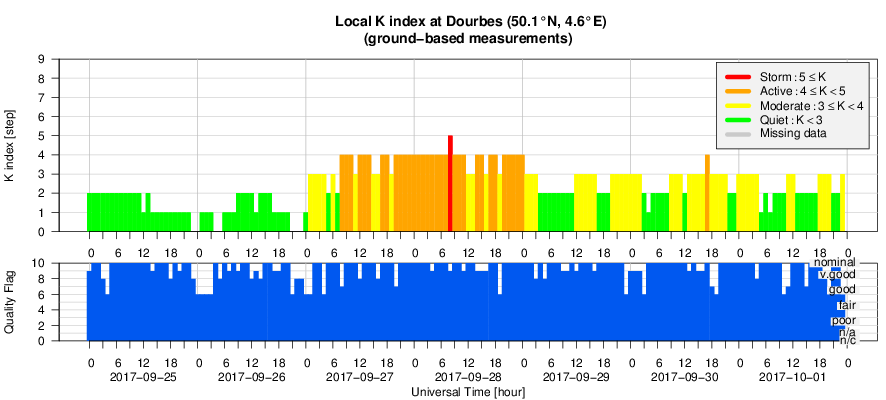- Table of Content
- 1.Facing the Sun
- 2.PROBA2 Observa...
- 3.Release of a n...
- 4.Review of sola...
- 5.The Internatio...
- 6.Geomagnetic Ob...
- 7.The SIDC Space...
- 8.Review of iono...
- 9.Future Events
2. PROBA2 Observations (25 Sep 2017 - 1 Oct 2017)
3. Release of a new LYRA product
4. Review of solar and geomagnetic activity
5. The International Sunspot Number
6. Geomagnetic Observations at Dourbes (25 Sep 2017 - 1 Oct 2017)
7. The SIDC Space Weather Briefing
8. Review of ionospheric activity (25 Sep 2017 - 1 Oct 2017)
9. Future Events
Facing the Sun
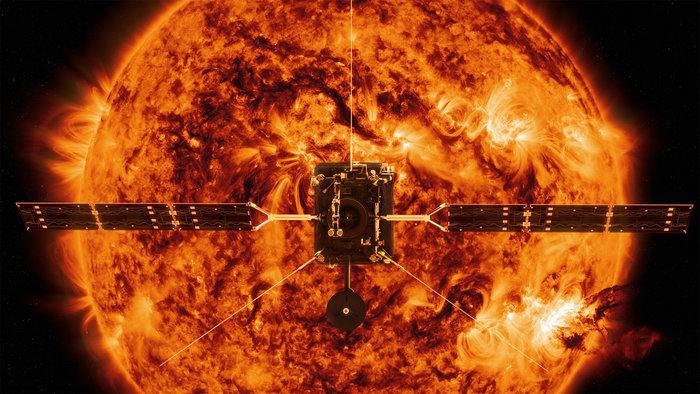
An artist's impression of ESA's Solar Orbiter in front of a stormy Sun. Now being fitted with its state-of-the-art instruments, Solar Orbiter is set to provide new views of our star, in particular providing close-up observations of the Sun’s poles.
Following its launch in February 2019 and three-year journey using gravity swingbys at Earth and Venus, Solar Orbiter will operate from an elliptical orbit around the Sun approaching within 42 million kilometers, closer than the planet Mercury.
The spacecraft will combine in situ and remote sensing observations to gain new information about solar activity and how eruptions produce energetic particles, information about what drives the solar wind and the coronal magnetic field, and how the Sun’s internal dynamo works.
Its 10 scientific instruments (e.g. the Extreme Ultraviolet Imager - see the STCE news items at http://www.stce.be/news/387/welcome.html and http://www.stce.be/news/377/welcome.html ) are in the final stages of being added to the spacecraft before extensive tests to prepare it for the 2019 launch from Cape Canaveral, USA.
Solar Orbiter is an ESA-led mission with NASA participation. Find out more here: http://www.esa.int/spaceinimages/Images/2017/10/Facing_the_Sun
(Source: ESA; Pic: ESA/ATG medialab; Sun: NASA/SDO/ P. Testa (CfA))
PROBA2 Observations (25 Sep 2017 - 1 Oct 2017)
Solar Activity
Solar flare activity fluctuated between very low and low during the week.
In order to view the activity of this week in more detail, we suggest to go to the following website from which all the daily (normal and difference) movies can be accessed: http://proba2.oma.be/ssa
This page also lists the recorded flaring events.
A weekly overview movie can be found here (SWAP week 392).
http://proba2.oma.be/swap/data/mpg/movies/weekly_movies/weekly_movie_2017_09_25.mp4
Details about some of this week’s events, can be found further below.
If any of the linked movies are unavailable they can be found in the P2SC movie repository here
http://proba2.oma.be/swap/data/mpg/movies/
Tuesday Sep 26
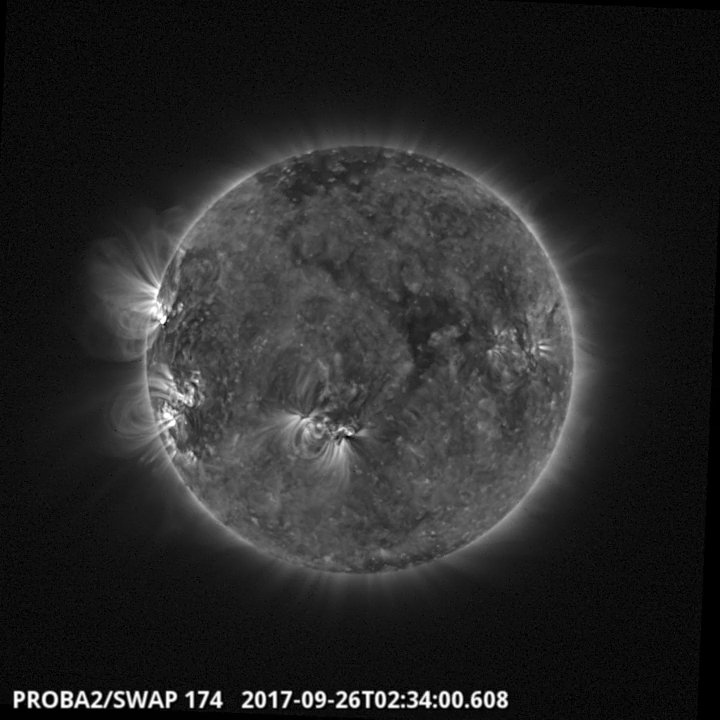
The first C-class flare of the week (C1.8) occurred from AR 2683 on 2017-Sep-26. The flare and corresponding eruption can be seen in the North-East part of the Sun at 02:34 UT in the SWAP image above. Find a movie of the event here (SWAP movie)
http://proba2.oma.be/swap/data/mpg/movies/20170926_swap_movie.mp4
Wednesday Sep 27
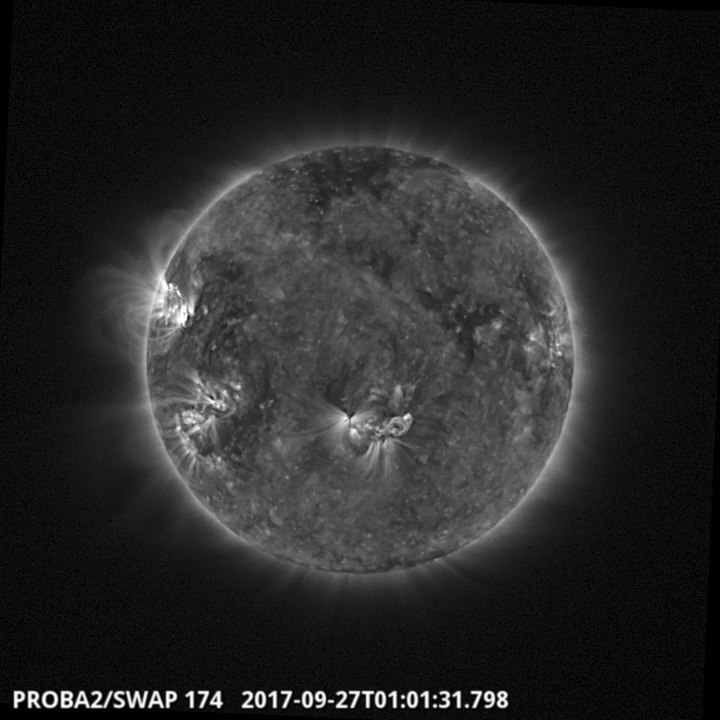
The second C-class flare of the week (C1.7) occurred from AR 2683 on 2017-Sep-27. The flare and corresponding eruption can be seen on the North-East part of the Sun at 01:01 UT in the SWAP image above.
Find a movie of the event here (SWAP movie)
http://proba2.oma.be/swap/data/mpg/movies/20170927_swap_movie.mp4
Release of a new LYRA product
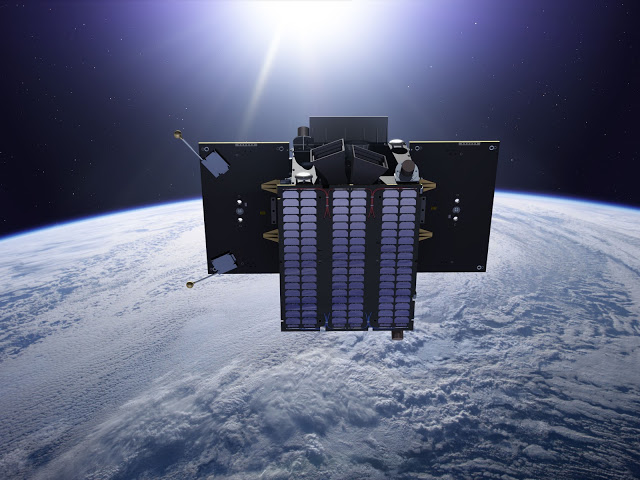
The PROBA2 team is happy to announce the release of a new data product: the Earth atmosphere O+N2 (Oxygen and Nitrogen) number density profiles. These profiles are derived from solar occultation measurements by LYRA and are available at http://proba2.oma.be/lyra/data/EarthAtmosphere/. LYRA (Large Yield RAdiometer, formerly LYman alpha RAdiometer) is an ultraviolet irradiance radiometer that observes the Sun in four passbands, chosen for their relevance to solar physics, aeronomy and space weather. This instrument can also detect flares and analyze the atmospheric composition of the Earth.
These number density profiles are produced daily from beginning of December till end of January and are based on the backup unit (unit 3) measurements to limit the impact of instrumental degradation. The O+N2 number density profiles cover altitudes ranging from 150 to 400km, a region of the atmosphere that has been historically difficult to measure. These data are therefore ideal to help validate atmosphere models or to characterize the thermospheric variability due to space weather events, such as solar flares and coronal mass ejections. This new data product is the result of a fruitful collaboration with Dr. E. Thiemann from the Laboratory for Atmospheric and Space Physics, Boulder, Colorado in the frame of the PROBA2 Guest Investigator Program. More information is available at http://proba2.oma.be/data/lyra/OplusN2
Source text by Marie Dominique and the PROBA2 team.
Review of solar and geomagnetic activity
SOLAR ACTIVITY
Over the past week the solar activity was low.
Catania sunspot group 57 (NOAA active region 2683) produced two C class flares (C1.8 flare peaking at 02:34 UT on September 26; C1.7 flare peaking at 01:01 UT on September 27). Catania sunspot group 56 (NOAA active region 2682) had drastically decayed with respect to its previous transit over the solar disk. It produced only a few B-class flares over the week.
Both sunspot groups are in the SDO/HMI image below.
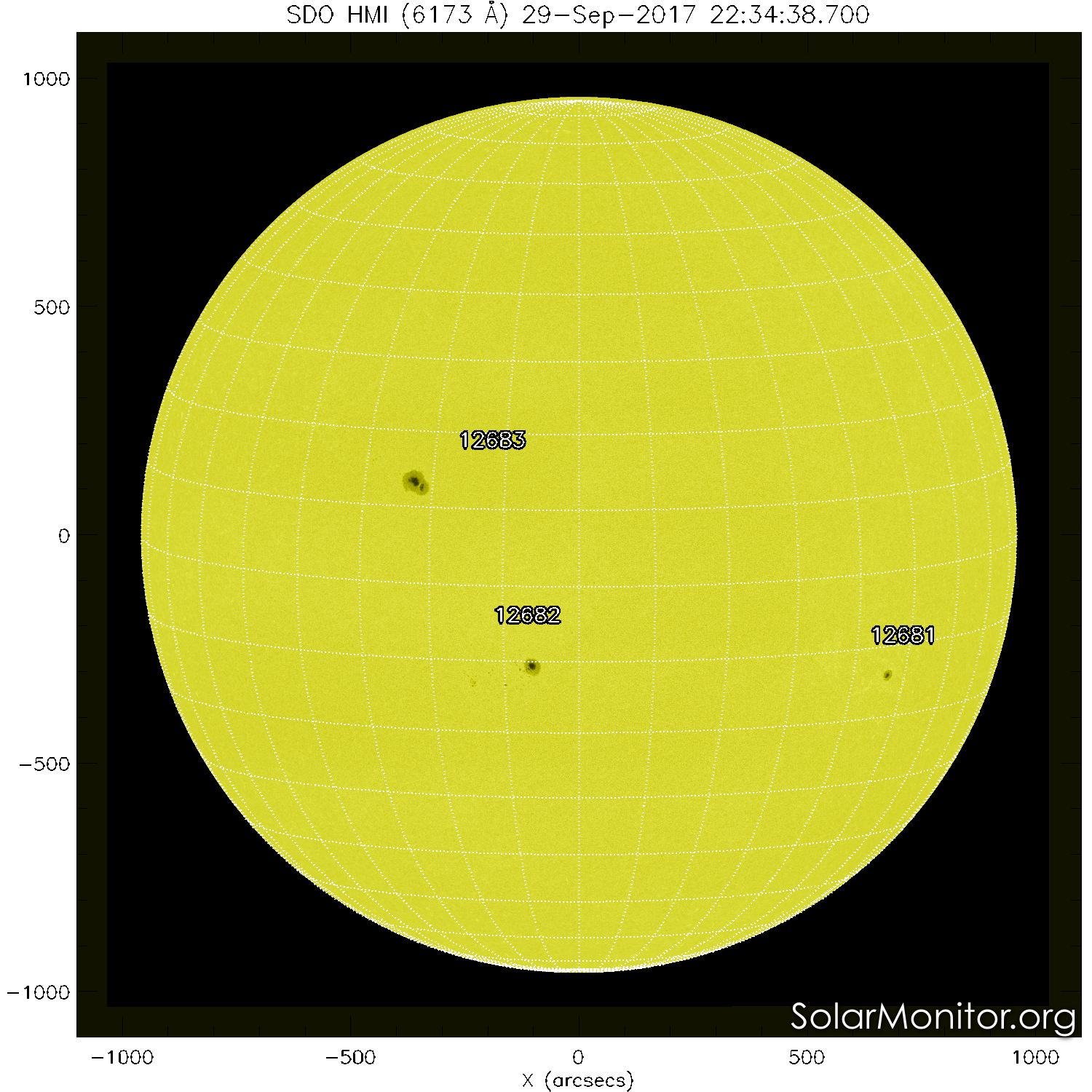
No Earth directed coronal mass ejections were observed. The proton flux with energies above 10 MeV remained at background level.
GEOMAGNETIC ACTIVITY
Geomagnetic conditions were quiet to unsettled from September 25 to September 27. On September 27, the fast solar wind from a positive coronal hole arrived at Earth. The solar wind speed reached values slightly above 700 km/s on September 28, with the southward component of the interplanetary magnetic fields reaching values as low as - 15 nT. The co-rotating interaction region preceding the fast wind, was far more dense compared to high speed solar wind. This increased density combined with negative Bz caused a major storm at the planetary level (Kp = 7) and locally a minor storm (K Dourbes = 5) in the period September 27-28.
Later on, the geomagnetic conditions returned to quiet levels with a few isolated active episodes.
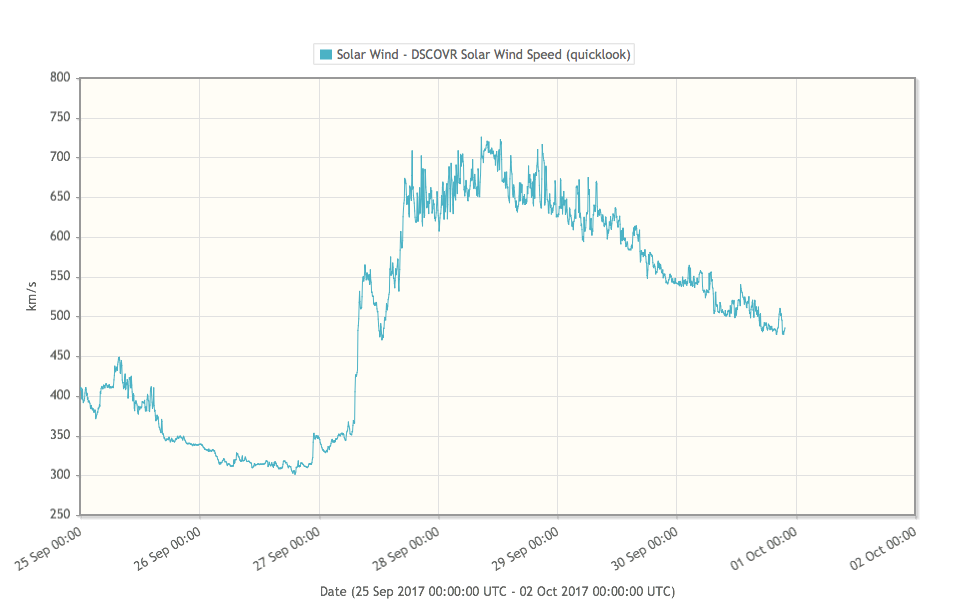
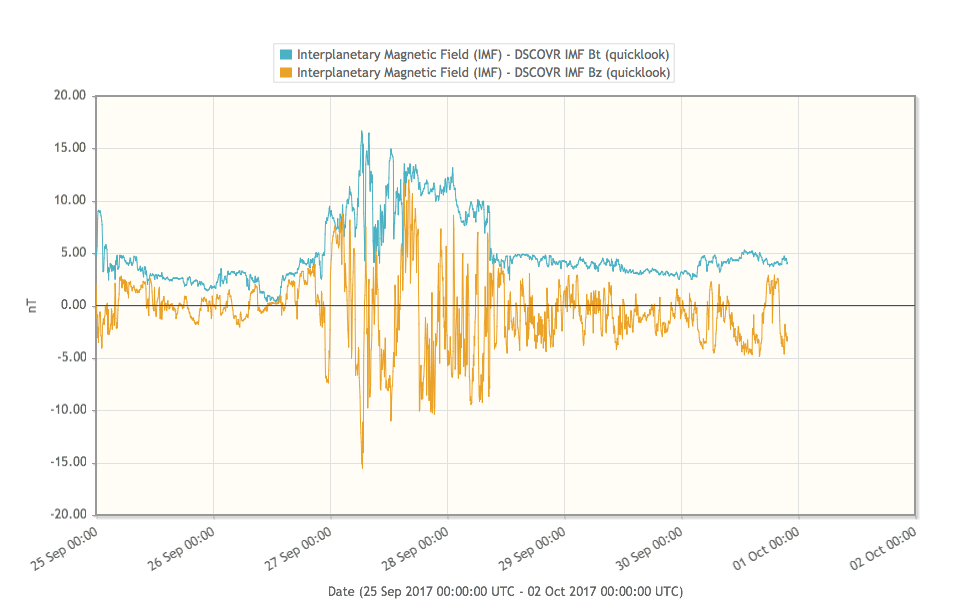
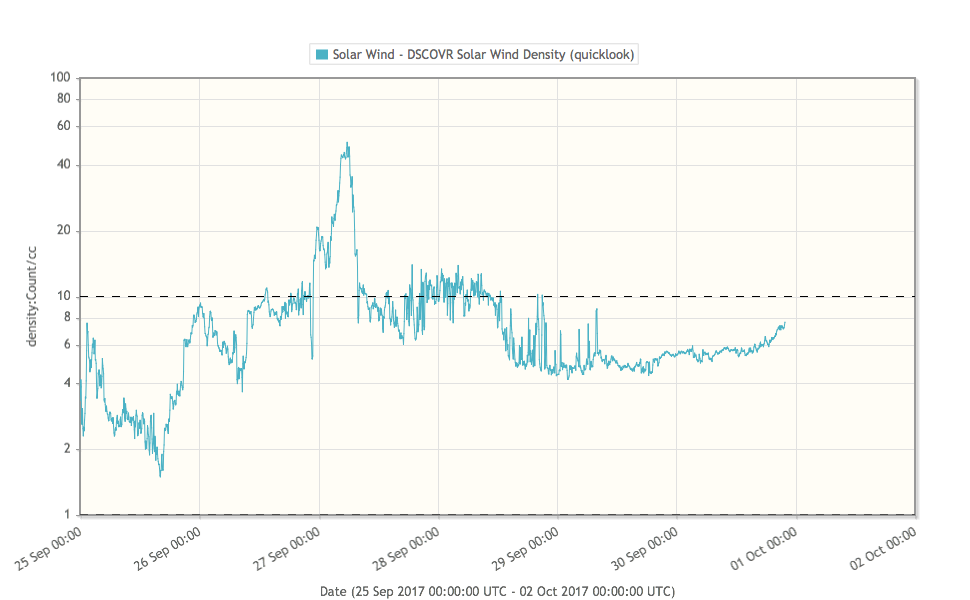
The International Sunspot Number
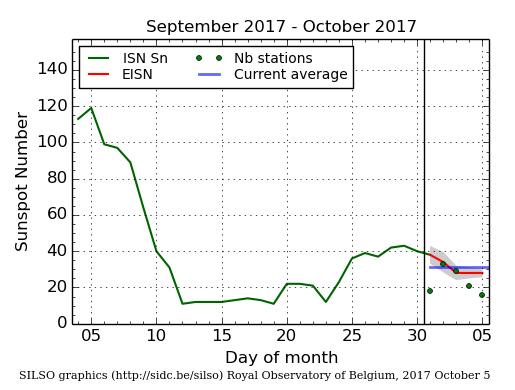
The daily Estimated International Sunspot Number (EISN, red curve with shaded error) derived by a simplified method from real-time data from the worldwide SILSO network. It extends the official Sunspot Number from the full processing of the preceding month (green line). The plot shows the last 30 days (about one solar rotation). The horizontal blue line shows the current monthly average, while the green dots give the number of stations included in the calculation of the EISN for each day.
The SIDC Space Weather Briefing
The Space Weather Briefing presented by the forecaster on duty from September 25 to October 1. It reflects in images and graphs what is written in the Solar and Geomagnetic Activity report.
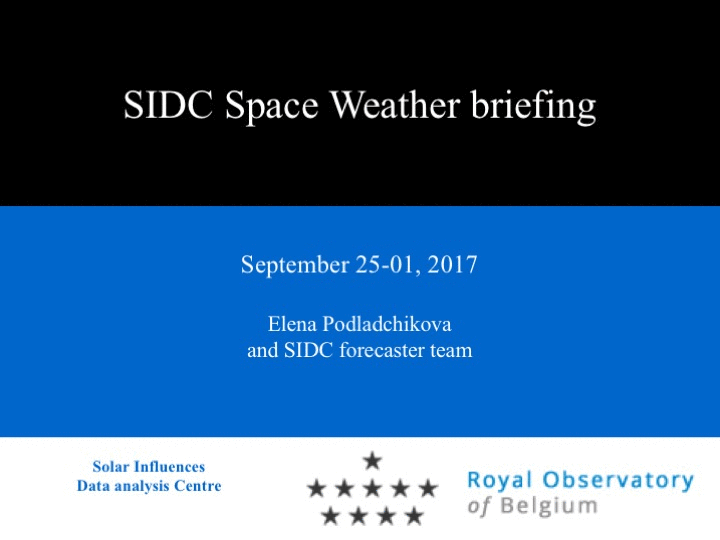
Review of ionospheric activity (25 Sep 2017 - 1 Oct 2017)
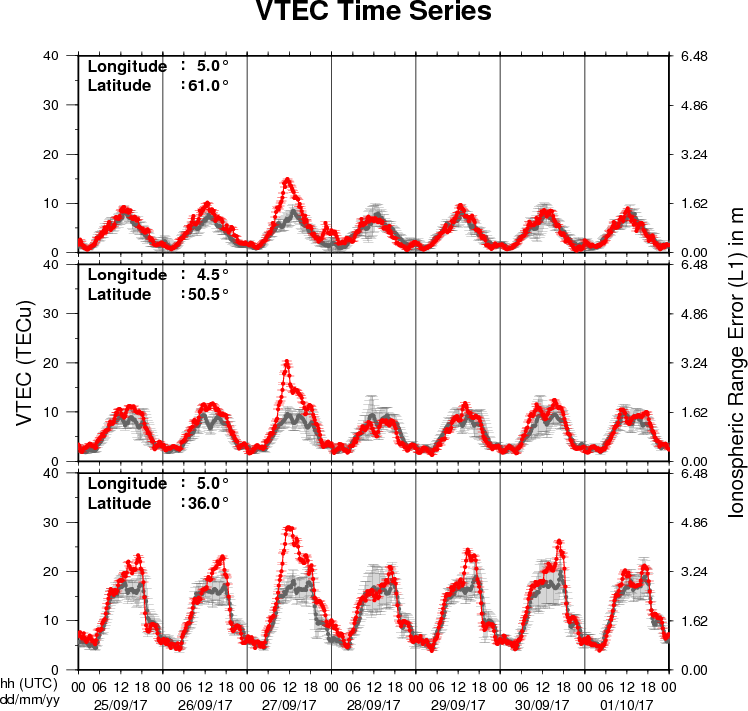
The figure shows the time evolution of the Vertical Total Electron Content (VTEC) (in red) during the last week at three locations:
a) in the northern part of Europe(N61°, 5°E)
b) above Brussels(N50.5°, 4.5°E)
c) in the southern part of Europe(N36°, 5°E)
This figure also shows (in grey) the normal ionospheric behaviour expected based on the median VTEC from the 15 previous days.
The VTEC is expressed in TECu (with TECu=10^16 electrons per square meter) and is directly related to the signal propagation delay due to the ionosphere (in figure: delay on GPS L1 frequency).
The Sun's radiation ionizes the Earth's upper atmosphere, the ionosphere, located from about 60km to 1000km above the Earth's surface.The ionization process in the ionosphere produces ions and free electrons. These electrons perturb the propagation of the GNSS (Global Navigation Satellite System) signals by inducing a so-called ionospheric delay.
See http://stce.be/newsletter/GNSS_final.pdf for some more explanations ; for detailed information, see http://gnss.be/ionosphere_tutorial.php
Future Events
For more details, see http://www.spaceweather.eu/en/event/future
International Workshop on Solar, Heliospheric & Magnetospheric Radioastronomy in Meudon, France
Start : 2017-11-06 - End : 2017-11-10
Jean-Louis Steinbeg has been one of the major pioneers in
radioastronomy. Co-founder of the Nançay Observatory, he
has actively participated to, an inspired a large number of radio
instruments on many international space missions. Jean-Louis
Steinberg is the founder of the Space Radioastronomy laboratory of
the Paris Observatory in 1963. Later on, this laboratory widened
its science interests and became the DESPA (1971) and then the
current LESIA (2002) which is one of the major space sciences
laboratories in France. The aim of this workshop is to cover the
science topics which Jean-Louis Steinberg has promoted during his
career, focusing on Solar, Heliospheric & Magnetospheric
radioastronomy & physics. This will be done by covering both
observations from either ground facilities (NDA, RH, LOFAR, Artemis
etc ...) or space missions (ISSEE, Ulysses, WIND, CLUSTER, STEREO,
CASSINI, JUNO etc ...) and models/theories. A series of invited
talks is also foreseen to cover the new developments in the
discipline which may come with the future facilities such as Solar
Orbiter, Solar Probe Plus, JUICE, JUNO, LOFAR+, SKA etc ....
This workshop will also be the opportunity to remember both the
extraordinary personal & professional lifes of Jean-Louis
Steinberg especially for new generation of scientists. At the
occasion of this workshop it is also expected that the Building 16
(historical Space Sciences building) on the Meudon campus will be
renamed "Building Jean-Louis Steinberg".
Website:
https://jlsworkshop.sciencesconf.org/
European Space Weather Week 14
Start : 2017-11-27 - End : 2017-12-01
The ESWW is the main annual event in the European Space Weather
calendar. It is the European forum for Space Weather as proven by
the high attendance to the past editions. The agenda will be
composed of plenary/parallel sessions, working meetings and
dedicated events for service end-users. The ESWW will again adopt
the central aim of bringing together the diverse groups in Europe
working on different aspects of Space Weather.
Website:
http://www.stce.be/esww14/
